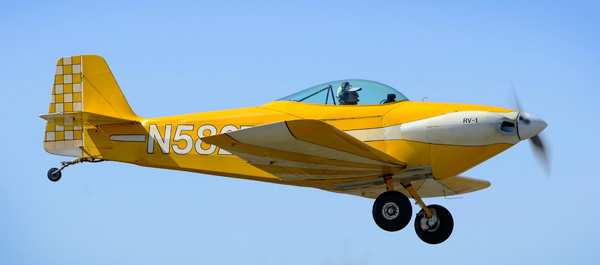
The very first RV-1 is back in the air and on its way to enshrinement in the EAA’s AirVenture Museum after a one-year restoration.
In the 1970s, the aircraft homebuilder’s rock star was Burt Rutan, designer of some of the most unconventional kitplanes aloft—notably the VariEze, Long-EZ and Quickie. Meanwhile, Richard VanGrunsven, a young engineer in Oregon with a name that nobody who wasn’t an EAA member would recognize today, was also beginning to produce homebuilt kits, but for a thoroughly conventional airplane that became the progenitor of an entire family of homebuilts. RVs, as the airplanes were called, would go on to wildly outsell and outperform Rutan’s quirky composite canards: first the single-seat RV-3, then the two-place RV-4 and RV-6, and a slew of others—two- and four-seaters, tailwheel and trigear versions, tandems and side-by-sides, all with a variety of engines. To date, more than 7,600 RVs have been built and flown, with thousands more under construction around the world. No other homebuilt line, and few factory-built lightplanes, has come close to that number.
The airplane that started it all, the RV-1 prototype, was based on a flawed 1950s design, the Stits Playboy. VanGrunsven bought a Stits and added a bigger tail and a slightly larger engine. But most crucially, he replaced its awkwardly strutted wood-and-fabric wing with a new, all-aluminum cantilever unit with a different airfoil that radically transformed the Playboy’s performance and handling qualities. Further modified and built entirely of aluminum, the RV-1 begat the RV-3 and rewrote kit-building history. (The RV-2 was a flying-wing sailplane that VanGrunsven designed but never completed.)
VanGrunsven’s RV-3 and its progeny hit a homebuilder sweet spot. They were inexpensive, straightforward and also easy to build, and they offered remarkable speed and performance. The RVs were all-metal with enclosed cockpits and offered true cross-country performance at a time when many homebuilts were still rag-and-tube, open-cockpit “playplanes” of limited utility.
That very first RV-1 is back in the air and on its way to enshrinement in the EAA’s AirVenture Museum after a one-year restoration. The project was accomplished by Paul Dye, who found the RV-1 sitting unflown for five years in Houston, Texas, where it had suffered some damage in a landing accident. Dye established a nonprofit foundation and funded the RV-1 rebuild with generous contributions of money, parts, work and material from the RV community—thousands of owner/builder enthusiasts delighted to see a historic homebuilt honored and admired. Go to rv-1.org for more on this iconic little airplane.




